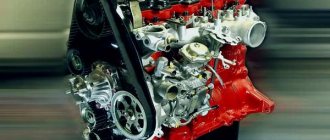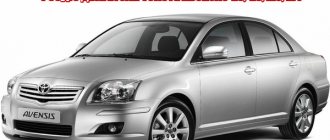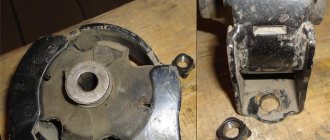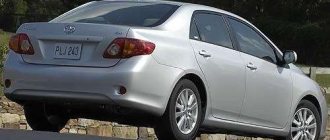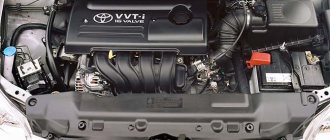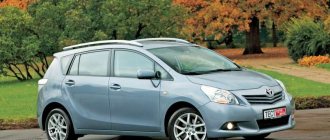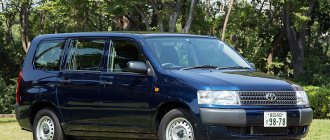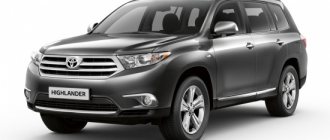3ZR engines are four-cylinder engines with a 16-valve gas distribution mechanism. The production of internal combustion engines (ICE) of this series began in 2007 and continues at Toyota enterprises to this day. Below we will talk about the technical characteristics, shortcomings and problem units, modifications and options for improving the 3-FE unit.
Which Toyota cars are equipped with 3ZR-FE?
Toyota 3ZR-FE units are installed on several models of the automaker. These power plants have a long service life and moderate fuel consumption.
Corolla E150
The 2-liter unit appeared on the front-wheel drive Corolla model in 2007. The engine is equipped with a Dual VVT-i variable valve timing complex. In some markets it is designated as 3ZR-FBE.
Corolla E170
The Corolla E170 engine differs from the 1ZR and 2ZR models by increasing the piston stroke to 97.6 mm. Other specifications are identical - dual VVTi, 143 hp. (there are models with increased boost to 151 hp).
RAV4 4 (XA40)
On the secondary market, the crossover can be found with a 2-liter power unit producing 146 hp. According to the owners, the engine is capable of operating up to 250 thousand kilometers without breakdowns or special interventions.
Avensis 3 (T270)
For the first time, Japanese engineers installed the 3ZR-FE on the Avensis in 2009. The engine is also successfully used in new mid-size sedan or station wagon cars.
Other models
In addition, the motor can be found on the following Toyota models:
- Allion.
- Noah.
- Premio.
- Voxy.
- Wish.
Additional improvements
Toyota is the first automobile company to use the Valvematic system on its cars. 3ZR-FAE Valvematic is a system for smoothly changing valve lift height. One of the cars that was equipped with this system was the Toyota Avensis released in 2009. In addition, some details have been improved on the new ZR engine series, which has improved overall performance. Improvements were made: hydraulic compensators and crankshaft desaxing. Owners of cars of the Corolla family could experience these improvements, because this particular modification of the engine was installed on these cars. Later they began to be installed on models of classes “B”, “C” and “D”, as well as on minivans and SUVs based on them, for example on the Toyota Isis and RAV4.
3ZR engine characteristics
The technical specifications of the power unit depend on 2 systems:
- Dual VVT-i - gas distribution complex with 2 camshafts (one each for the intake and exhaust valves).
- Valcematic - fuel-air mixture control systems (used on engines marked 3ZR-FAE.
The engine has a solid block with 4 cylinders (each has 4 valves). DOHC is used as the main circuit. The block is made of impact-resistant aluminum, and the sleeves are cast iron.
The engine capacity stated in the technical data sheet is 1986 cc. cm, i.e. 2.0 l. Power, depending on modification, is 142–158 hp, and rotational potential is 194 Nm at 3900 rpm.
The engine can run on AI-92 and AI-95 gasoline fuels. The amount of lubricating mixture in the power plant is 4.2 liters. Manufacturers claim an operational life of 250 thousand km.
Line of power units
Toyota does not hide the fact that each new generation of the model is mainly intended for the young category of drivers aged 25-30 years. A bold statement, one might say that it is even a challenge. However, the Japanese do not go back on their words at all - they are constantly offering new configurations. The line of Rav 4 power units is updated with enviable frequency, as is the design, interior and functionality of the crossover. Initially, the model was equipped with a 2.0-liter 3S-FE engine with a power of 135 horsepower; after some time, a modification of the 3S-GE engine with 178 horsepower appeared. Both engines are combined with a manual or automatic transmission.
Performance characteristics of 3S-FE:
- Engine type: 4-cylinder DOHC;
- Fuel used: AI-92, AI-95;
- Cylinder diameter: 82 mm;
- Number of valves: 16;
- Valves per cylinder: 4;
- Potential resource: 400 thousand km.
It is worth saying that Toyota has always had not only all-wheel drive, but front-wheel drive modifications that found buyers in North America and Japan. Already with the release of the 2nd generation, the Japanese are offering new power plant options: 2-liter 1AZ-FE, 1AZ-FSE with 150 horsepower, 2.4-liter 2AZ-FE and 2AZ-FSE with a stated power of 160 hp. The two-liter diesel D-4D, which is characterized by good traction, also finds its buyers.
Characteristics of 1AZ-FE:
- Engine type: 4-cylinder DOHC;
- Fuel used: AI-95;
- Environmental standard: Euro-5
- Cylinder diameter: 86 mm;
- Potential resource: 400 thousand km.
But, perhaps, the Japanese offer the greatest variety with the release of the 4th generation Toyota Rav 4. At this time, two new turbodiesels of 2.0 and 2.2 liters immediately appeared. The 2.4 engine, which has gone down in history, is successfully replacing the structurally improved 2.5-liter engine with a capacity of 180 horsepower. As for the popularity of certain types of power plants, the 2.0-liter gasoline engine 1AZ-FE is most loved by domestic drivers - it is unpretentious, reliable, and resource-intensive. The 2.2-liter turbodiesel, which appeared in the fourth generation of the crossover, is also gaining popularity.
Engine design
The 3ZR-FE series engines have a light alloy block, which is equipped with an open cooling circuit. The sleeves are integrated into the aluminum surface, and their outer part has a characteristic unevenness. This ensures reliable fixation of the elements and has a positive effect on heat dissipation. Between the cylinders there is a wall 7 mm thick.
The crankshaft is equipped with 8 counterweights with journals of reduced width, which reduces losses. A large cast crankcase is fixed to the block, which is used as an oil pan.
The pistons are made of light alloys and have a T-shaped configuration.
The engine has a vertical arrangement in the engine compartment, which simplifies its maintenance or repair in case of failure.
3ZR-FE engine in the engine compartment.
Oil for Toyota Harrier hybrid
The hybrid engine must be filled with synthetic original low-viscosity motor oil. It costs more than its analogues, but the result justifies the expense - parts are subject to less wear, heat is dissipated better, and friction is reduced, as a result, fuel consumption also drops.
Quite often, owners of hybrids with engines A25A-FXS, 2AR-FXE, 3MZ-FE pour too thick oil from the first days of operation. As a result, the rubbing surfaces quickly wear out over time, and gaps and grooves appear. With the transition to the recommended 0W-20, oil consumption increases noticeably. The low-viscosity liquid quickly fills the formed voids. Therefore, only 0W-20 or, in extreme cases, 5W-20 with API SN approval should be poured into the hybrid, and the oil should be changed as often as possible.
Video on the topic:
Fuel consumption
The Japanese-made power unit is distinguished by moderate fuel consumption.
If we take into account the performance of the Toyota RAV4 with an all-wheel drive platform and a variable transmission, then gasoline consumption in different driving modes is as follows:
- Operation in the urban cycle - 9.4 l/100 km.
- Driving on the highway - 6.4 l/100 km.
- Mixed driving mode – 7.5 l/100 km.
The 3ZR-FA engine, which is used in the Toyota Avensis, with identical volume and variable transmission, produces the following indicators:
- Urban mode - 9.2 l/100 km.
- Highway – 5.7 l/100 km.
- Combined cycle - 7.7 l/100 km.
Among the advantages of the engine are its efficiency. At the same time, the exact fuel consumption directly depends on the weight of the car and driving style.
Toyota RAV4 uses 6.4 liters of fuel per 100 km.
Toyota 3ZR engine modifications
The Toyota 3ZR power unit is presented in 3 modifications. The most popular is the basic version 3ZR-FE.
3ZR-FE
The first engine in the range, designated 3ZR-FE, is equipped with 2 camshafts for the valves. Its power is 143 hp.
3ZR-FAE
The modernized modification of FAE has the Valmatic complex. The electronic system constantly analyzes the characteristics of the driving mode and adjusts the length of the intake valve stroke.
She is also responsible for selecting the optimal composition of the fuel-air mixture based on the loads. Power 3ZR-FAE – 155 hp. There are no other differences from the previous motor.
The 3ZR-FAE has a power of 155 hp.
3ZR-FBE
FBE series power units are capable of running on biofuel. The power reserve is 151 hp. The engine can be found in the Toyota Corolla for the Brazilian car market.
Weaknesses of the Toyota engine
The main negative qualities of the engine were carried over from the previous 2ZR line.
Among them:
- Increased fuel consumption with aggressive driving style. With moderate acceleration, smooth gear shifting and maintaining medium speeds, the problem does not appear.
- Noisy work. At increased loads the engine becomes quite noisy.
- Pump leaking. During operation, this element of the power plant wears out, causing leaks to form.
- Vibration at idle. For units with a mileage of more than 200,000 km, the problem is felt quite strongly.
Among the actual difficulties faced by car owners are:
- Difficulties in overhauling the power unit.
- Stretching of the timing chain, which contributes to increased noise (the problem is solved after installing a new mechanism).
- Difficulties with cold starting, as well as knocking in the timing belt (it is important to take a responsible approach to choosing the fuel mixture, as well as to replace technical fluids and filters on time).
- The appearance of failures at start-up (to get rid of this unpleasant phenomenon, you need to reset the electronic control unit).
- Contamination of fuel filters with low-quality fuel.
- Failure of hydraulic compensators due to the use of unsuitable oil.
- Damage to the sealing collars on the valve.
To extend the life of the unit, it is necessary to properly maintain it and not overload it.
Disadvantages and defects
Despite most of the improvements and many improvements, these engines had significant shortcomings that cannot be ignored. During operation, you can notice obvious defects, some of which are accompanied by strong knocking of the drives and noise of the vacuum pump. Main disadvantages during operation:
- frequent oil changes;
- large slag residues at the bottom of the combustion chambers;
- pump leaks and frequent oil leaks from under the chain cover;
- Valvematic controller errors;
- sudden engine shutdown due to program failure.
3ZR-FAE without protective casing Despite all this, the ZR engine series, including the 3ZR-FAE engine, remains one of the best of its kind. Previously produced series had problems with huge oil consumption, but now this problem has become less terrifying than before. Oil consumption became from 250 to 350 ml. per 1000 km. In order to somehow reduce consumption, it is recommended to use oils that have a higher viscosity. According to official documents, the 3ZR-FAE engine mentions some other possible problems that may arise during operation. These are mainly errors of some electronic programs, such as EVAP errors, problems with hot starting and loud noise of the coolant pump, and also some parts require frequent replacement.
3ZR engine tuning
If you want to increase the power of pumping equipment, reduce resistance and optimize cylinder purging, you should not expect any special improvements in the operation of the unit.
To obtain visible changes, it is necessary to flash the electronic unit, upgrade the cylinder head by expanding the channels by boring, and also update the injector set.
In auto repair shops, such actions are called porting, or porting. After the measures are taken, the power of the unit will be increased by 15–20 hp.
Installing an S14 compressor with nozzles from 2ZZ-GE will allow you to get a boost of 180 hp.
Avensis with a tuned 3ZR engine increases power by 20 hp.
Turbine installation
The use of a Garret GT28 turbine together with new injectors, a stitched electronic control unit, an upgraded fuel pump and exhaust system will improve engine performance up to 300 hp.
However, such changes will negatively affect the service life of the installation and lead to premature wear of important components. Therefore, such modernization does not justify itself.

